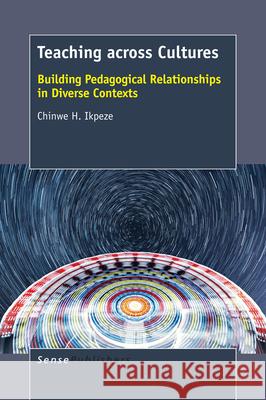Teaching across Cultures » książka
Teaching across Cultures
ISBN-13: 9789462099821 / Angielski / Twarda / 2016 / 226 str.
Teaching across Cultures
ISBN-13: 9789462099821 / Angielski / Twarda / 2016 / 226 str.
(netto: 420,89 VAT: 5%)
Najniższa cena z 30 dni: 423,64
ok. 30 dni roboczych
Dostawa w 2026 r.
Darmowa dostawa!
Teaching across Cultures: Building Pedagogical Relationships in Diverse Contexts captures the tensions, complexities as well as the transformational potentials of teaching across multiple cultural contexts. The book evolved from cumulative self-studies that examined one teacher educator's teaching practice, the cultural impact on this practice, and how she facilitated transformative teaching and learning. While every act of teaching occurs across cultures such as institutional culture, invisible cultures, classroom cultures, among others, educators who teach as cultural outsiders have to navigate the tensions, complexities and contradictory realities of cross-cultural teaching. The tensions can be reduced or managed through responsive pedagogy, relationship building and teaching in the third space. These transformational approaches not only help to identify and close the perpetual gaps in teaching and learning but also position effective teaching within a pedagogical common ground that values student voices, facilitates pedagogical flexibility and uses diversity as a teaching tool. In a world of ubiquitous and interactive learning environments, both the physical and virtual spaces play a vital role in teaching and teacher-student relationships. The book points to the necessity of teacher educators' learning through diverse professional networks but more importantly through self-study. It is only through this introspective examination of one's teaching and students' learning as well as taking an ontological attitude to teaching that educators can achieve success in diverse contexts.
Teaching across Cultures: Building Pedagogical Relationships in Diverse Contexts captures the tensions, complexities as well as the transformational potentials of teaching across multiple cultural contexts. The book evolved from cumulative self-studies that examined one teacher educators teaching practice, the cultural impact on this practice, and how she facilitated transformative teaching and learning. While every act of teaching occurs across cultures such as institutional culture, invisible cultures, classroom cultures, among others, educators who teach as cultural outsiders have to navigate the tensions, complexities and contradictory realities of cross-cultural teaching. The tensions can be reduced or managed through responsive pedagogy, relationship building and teaching in the third space. These transformational approaches not only help to identify and close the perpetual gaps in teaching and learning but also position effective teaching within a pedagogical common ground that values student voices, facilitates pedagogical flexibility and uses diversity as a teaching tool. In a world of ubiquitous and interactive learning environments, both the physical and virtual spaces play a vital role in teaching and teacher-student relationships. The book points to the necessity of teacher educators learning through diverse professional networks but more importantly through self-study. It is only through this introspective examination of ones teaching and students learning as well as taking an ontological attitude to teaching that educators can achieve success in diverse contexts.











